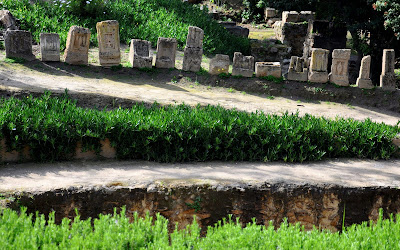

Tarek was right, there wasn't much left of Carthage to see, but I didn't care, my imagination could fill in the empty spaces. What we see in these first two pictures are stelae, or grave markers, in the area called the "Tophet". That is a Hebrew word designating a place of sacrifice and it has been applied to the site based on unreliable Roman reports that the Carthaginians indulged in systematic child sacrifice. Recent research, however, suggests that the site was simply a graveyard where the cremated remains of children and animals that died either before or shortly after birth were buried.


The stelae on display had all been excavated from underground chambers along with jars holding the cremated remains of children and animals. We were able to enter one of these chambers to view stelae as they were originally found. Spooky, no?

After a few minutes contemplating dead children and pets it was a relief to emerge once again above ground to bask in the glorious Mediterranean sunlight.

From the Tophet we traveled to the nearby port of Carthage. Here's a representation of how the harbor looked in Roman times, which is a fair approximation of the dimensions of the old Punic port. The inner, circular port was for warships; the outer, rectangular one was for commercial vessels.

Here's what the outer harbor looks like today.

And this is a view of the inner, military, harbor. I was struck by how small the harbors were -- I had imagined them to be much larger. The hill in the background is the "Byrsa", or citadel which was the seat of government and residence of the Carthaginian elites. Today the entire area is home to Tunisian elites, which helps to explain why there is so little left to see of the ancient capital of empire. The Romans destroyed and built over most of what they conquered, and the owners of today's luxury villas have no interest in having archaeologists digging up their backyards. There are some ruins to be seen on the hill, but they aren't very extensive. So, a better visual experience of ancient Carthage will have to wait for a future generation of tourists. The large structure near the top of the hill is the Cathedral of St. Louis, built by French authorities in the 1890''s to mark the place where the crusading King Louis IX died back in the Thirteenth Century. Today it is just a cultural site and does not function as a Christian church.
No comments:
Post a Comment